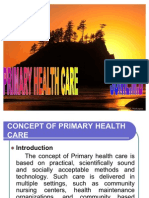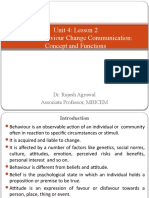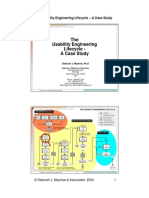0 ratings0% found this document useful (0 votes)
48 viewsUnit 1 Public Health: Definition and Concept: Dr. Rajesh Agrawal Associate Professor, MBICEM
Unit 1 Public Health: Definition and Concept: Dr. Rajesh Agrawal Associate Professor, MBICEM
Uploaded by
shrutiPublic health involves organized community efforts to prevent disease and promote health through activities like sanitation, infection control, education, and access to healthcare. It aims to ensure every citizen can achieve health and longevity. Public health efforts are organized at the community level through science and social approaches. Key functions include disease prevention, health promotion, identifying community health needs, and developing health policies. Major programs in India address issues like maternal/child health, disease control, and access to healthcare. Public health relies on multidisciplinary teams including physicians, epidemiologists, educators and others.
Copyright:
© All Rights Reserved
Available Formats
Download as PPTX, PDF, TXT or read online from Scribd
Unit 1 Public Health: Definition and Concept: Dr. Rajesh Agrawal Associate Professor, MBICEM
Unit 1 Public Health: Definition and Concept: Dr. Rajesh Agrawal Associate Professor, MBICEM
Uploaded by
shruti0 ratings0% found this document useful (0 votes)
48 views15 pagesPublic health involves organized community efforts to prevent disease and promote health through activities like sanitation, infection control, education, and access to healthcare. It aims to ensure every citizen can achieve health and longevity. Public health efforts are organized at the community level through science and social approaches. Key functions include disease prevention, health promotion, identifying community health needs, and developing health policies. Major programs in India address issues like maternal/child health, disease control, and access to healthcare. Public health relies on multidisciplinary teams including physicians, epidemiologists, educators and others.
Original Title
L1
Copyright
© © All Rights Reserved
Available Formats
PPTX, PDF, TXT or read online from Scribd
Share this document
Did you find this document useful?
Is this content inappropriate?
Public health involves organized community efforts to prevent disease and promote health through activities like sanitation, infection control, education, and access to healthcare. It aims to ensure every citizen can achieve health and longevity. Public health efforts are organized at the community level through science and social approaches. Key functions include disease prevention, health promotion, identifying community health needs, and developing health policies. Major programs in India address issues like maternal/child health, disease control, and access to healthcare. Public health relies on multidisciplinary teams including physicians, epidemiologists, educators and others.
Copyright:
© All Rights Reserved
Available Formats
Download as PPTX, PDF, TXT or read online from Scribd
Download as pptx, pdf, or txt
0 ratings0% found this document useful (0 votes)
48 views15 pagesUnit 1 Public Health: Definition and Concept: Dr. Rajesh Agrawal Associate Professor, MBICEM
Unit 1 Public Health: Definition and Concept: Dr. Rajesh Agrawal Associate Professor, MBICEM
Uploaded by
shrutiPublic health involves organized community efforts to prevent disease and promote health through activities like sanitation, infection control, education, and access to healthcare. It aims to ensure every citizen can achieve health and longevity. Public health efforts are organized at the community level through science and social approaches. Key functions include disease prevention, health promotion, identifying community health needs, and developing health policies. Major programs in India address issues like maternal/child health, disease control, and access to healthcare. Public health relies on multidisciplinary teams including physicians, epidemiologists, educators and others.
Copyright:
© All Rights Reserved
Available Formats
Download as PPTX, PDF, TXT or read online from Scribd
Download as pptx, pdf, or txt
You are on page 1of 15
Unit 1
Public Health: Definition and Concept
Dr. Rajesh Agrawal
Associate Professor, MBICEM
Public Health: Definitions
“Public health is the art and science of preventing
disease, prolonging life, and promoting health and
efficiency through organised community efforts for the
sanitation of the environment, the control of community
infections, the education of individuals, in principles of
personal hygiene, the organisation of medical and
nursing services for the early diagnosis and prevention
of disease, and the development of social machinery,
which will ensure to every individual of the community,
a standard of living adequate for the maintenance of
health, so organising these benefits as to enable every
citizen to realise his birth right of health and longevity”.
Public Health: Definitions
“Public health consists of organized efforts to
improve the health of communities. The operative
components of this definition are that public health
efforts are organized and directed to communities
rather than to individuals. Public health practice does
not rely on a specific body of knowledge and
expertise but rather relies on a combination of science
and social approaches. The definition of public health
reflects its central goal – the reduction of disease and
the improvement of health in a community.”
- Defining public health historical and contemporary
development
Public Health: Concept
Public health promotes and protects the health of people and the
communities where they live, learn, work and play.
wellness by encouraging healthy behaviours
public health assures the conditions to keep people healthy.
vaccinating children and adults to prevent the spread of disease
educating people about the risks of alcohol and tobacco.
sets safety standards to protect workers and
develops school nutrition programs to keep kids healthy
incorporates environmental health, community health,
behavioural health, health economics, public policy, insurance
medicine, mental health and occupational safety and health are
other important subfields.
Public health saves money, improves our quality of life, helps
children thrive and reduces human suffering.
Functions of Public Health
Prevent diseases and injuries.
Promote healthy lifestyles and good health
habits.
Identify, measure, monitor, and anticipate the
health needs of community.
Formulate, promote, and enforce essential
health policies.
Organise and ensure high-quality and cost-
effective public health and health care services.
Reduce health disparities and ensure access to
healthcare for all.
Functions of Public Health
Promote and protect a healthy environment.
Disseminate health information and mobilise
communities to take appropriate action to maintain
their health.
Plan and prepare for natural and man-made disasters.
Reduce interpersonal violence and aggressive wars.
Conduct research and evaluate health-promoting and
disease preventing strategies.
Develop new methodologies for research and
evaluation.
Train and ensure a competent public health workforce.
Public Health Policy in India
National Health Policy 1983
(i) A phased, time-bound programme for setting up a well dispersed
network of comprehensive primary health care services, linked with
extension and health education, designed in the context of the ground
reality that elementary health problems can be resolved by the people
themselves;
(ii) Intermediation through ‘Health volunteers’ having appropriate
knowledge, simple skills and requisite technologies;
(iii) Establishment of a well-worked out referral system to ensure
that patient load at the higher levels of the hierarchy is not needlessly
burdened by those who can be treated at the decentralized level;
(iv) An integrated network of evenly spread speciality and super-
speciality services; encouragement of such facilities through private
investments for patients who can pay, so that the draw on the
Government’s facilities is limited to those entitled for free use.
Public Health Policy
National Health Policy 2002
To achieve an acceptable standard of good health amongst the general
population of the country. The approach would be to increase access to the
decentralized public health system by establishing new infrastructure in
deficient areas, and by upgrading the infrastructure in the existing
institutions.
to ensuring a more equitable access to health services across the social
and geographical expanse of the country.
to increasing the aggregate public health investment through a
substantially increased contribution by the Central Government.
to preventive and first-line curative initiatives at the primary health level
through increased sectoral share of allocation.
Emphasis laid on rational (logical) use of drugs within the allopathic
system.
Increased access to tried and tested systems of traditional medicine will
be ensured.
Public Health Policy
National Health Policy 2015
The primary aim of the National Health Policy, 2015 is
to-
inform, clarify, strengthen and prioritize the role of the
government in shaping health systems in all its
dimensions- investment in health
organization and financing of healthcare services,
prevention of diseases and
promotion of good health through cross sectoral action,
access to technologies,
developing human resources,
encouraging medical pluralism,
building the knowledge base required for better health,
financial protection strategies and
Public Health Programs
National Health Mission (NHM): It include health system
strengthening in rural and urban areas, Reproductive-
Maternal-Neonatal-Child and Adolescent Health
(RMNCH+A) and Communicable and Non-Communicable
Diseases.
The NHM envisages achievement of universal access to
equitable, affordable & quality healthcare services that are
accountable and responsive to people’s needs.
The National Health Mission (NHM) encompasses its two
Sub-Missions,
1) The National Rural Health Mission (NRHM) and
2) The National Urban Health Mission (NUHM).
Major Public Health Programs
Maternal and Adolescent Healthcare
Child Health Programme
Disease Control Programmes
National Leprosy Eradication Programme
The Revised National TB Control Programme
National Iodine Deficiency Disorders Control Programme
Family Planning
National Programme For Prevention And Control Of
Cancer, Diabetes, Cardio Vascular Disease And Stroke
National Tobacco Control Programme
National Mental Health Programme
Major Public Health Programs
National Programme for Control of Blindness
National Programme For Prevention And Control Of
Deafness
National Programme For Prevention & Control Of
Fluorosis
National Programme For Healthcare Of The Elderly
National Oral Health Programme
Capacity Building For Development Trauma Care
Facilities In Government Hospitals
National Programme On Prevention And
Management Of Burn Injuries
Major Public Health Programs
Food Fortification (enriching nutritious food)
National Organ Transplant Programme
National Commission on Population
Adverse Child Sex-Ratio in India (age group of 0-6
years – as per 2011, 918 girls against 1000 boys)
Central Government Health Scheme
The Information, Education & Communication
Gender Issues (discrimination between male and
female access to nutritious food and medical access)
National Aids Control Organization
Public Health Professionals or workers
Modern public health practice requires multidisciplinary
teams of public health workers and professionals including -
physicians specializing in public health, specialist doctors,
psychologists, epidemiologists, biostatisticians, medical
assistants or Assistant Medical Officers, Health educators.
Scientists and researchers, public health nurses, midwives,
medical microbiologists, environmental health officers,
public health inspectors, pharmacists, dentists, dieticians,
and nutritionists, veterinarians, public health engineers,
public health lawyers, sociologists, community planners,
community development workers, communications experts,
social workers, health safety professionals, public policy
makers, sanitarians, bioethicists, and others.
Role of Public Health Professionals
to prevent problems from happening or recurring
through implementing educational programs,
recommending policies, administering services and
conducting research –
clinical professionals like doctors and nurses focuses
primarily on treating individuals after they become sick
or injured.
also works to limit health disparities.
promoting healthcare equity, quality and accessibility.
You might also like
- PLOC and Tesla SuccessDocument4 pagesPLOC and Tesla SuccessHumna Khalid100% (2)
- Public Health Nursing: Scope and Standards of PracticeFrom EverandPublic Health Nursing: Scope and Standards of PracticeRating: 5 out of 5 stars5/5 (1)
- Dental Public Health 2Document11 pagesDental Public Health 2El BeeNo ratings yet
- Overview of Public Health Nursing in The PhilippinesDocument35 pagesOverview of Public Health Nursing in The PhilippinesDarlen Rabano100% (2)
- Chapter 10Document32 pagesChapter 10Josua Mondol80% (5)
- Concept of PHCDocument43 pagesConcept of PHCVantrigaru Veeresh Bangi93% (14)
- Primary Health Care: Mr. John Michael M. Pitoy, B.S.N., R.NDocument44 pagesPrimary Health Care: Mr. John Michael M. Pitoy, B.S.N., R.NJohn Michael Manlupig Pitoy100% (9)
- C NCM 104 PrelimsDocument52 pagesC NCM 104 PrelimsPhoebe DavidNo ratings yet
- Primary Health Care - Goal, Principles, StrategiesDocument3 pagesPrimary Health Care - Goal, Principles, Strategieshanedina100% (10)
- Health Care Delivery System in IndiaDocument24 pagesHealth Care Delivery System in Indiarizwan89% (9)
- Corporate Solutions at Jones Lang Lasalle (2001) : HarvardDocument16 pagesCorporate Solutions at Jones Lang Lasalle (2001) : HarvardThe Panda Entertainer0% (2)
- HMC ScannerDocument12 pagesHMC ScannerHusseinMohamedHassanNo ratings yet
- History: Domino's Pizza IsDocument16 pagesHistory: Domino's Pizza IsPraveen PrabhakarNo ratings yet
- Unit - 1 Introduction To Public HealthDocument63 pagesUnit - 1 Introduction To Public HealthVedansha SinghalNo ratings yet
- Health Promotion, Primary Health Care and Model of PreventionDocument8 pagesHealth Promotion, Primary Health Care and Model of Preventionsuman guptaNo ratings yet
- Unit 1Document65 pagesUnit 1shrutiNo ratings yet
- Primary Health Care 1Document13 pagesPrimary Health Care 1Hannah Villavicencio100% (1)
- Strategic Direction2Document6 pagesStrategic Direction2Etsub ChekolNo ratings yet
- Term Paper For FumiDocument10 pagesTerm Paper For Fumiajiboyetitilayo64No ratings yet
- NSG 301 Community HealthDocument15 pagesNSG 301 Community HealthdoyinsolaolusanyaNo ratings yet
- Primary Health Care (PHC) Is An Essential Health Care Made UniversallyDocument9 pagesPrimary Health Care (PHC) Is An Essential Health Care Made UniversallyAlimyon Abilar MontoloNo ratings yet
- Primary Health Care Definition Goal ObjectivesDocument3 pagesPrimary Health Care Definition Goal Objectivesmarvinbreyes100% (10)
- Week 2 (PHC)Document28 pagesWeek 2 (PHC)Kate MassonNo ratings yet
- 2nd WeekDocument9 pages2nd WeekFH NadzNo ratings yet
- Inbound 5566500222241268010Document38 pagesInbound 5566500222241268010Hazel Jane MillamaNo ratings yet
- Lec 4Document6 pagesLec 4hartb9965No ratings yet
- Module 5 Unit 5 Introduction To Primary Health Care 3Document25 pagesModule 5 Unit 5 Introduction To Primary Health Care 3Alyanna AlcantaraNo ratings yet
- CHN ModuleDocument9 pagesCHN ModuleKimberly Marie BayangNo ratings yet
- PHC HistoryDocument7 pagesPHC HistoryShafie Osman AliNo ratings yet
- NCM 104 Lecture Chapter 2.2 - PHC and UhcDocument50 pagesNCM 104 Lecture Chapter 2.2 - PHC and UhcWilma Nierva Beralde50% (2)
- Health Promotion & PHCDocument39 pagesHealth Promotion & PHChiral mistry100% (1)
- Community Health Nursing (An Overview)Document4 pagesCommunity Health Nursing (An Overview)Ronel ResurricionNo ratings yet
- Health Promotion and Primary Health CareDocument51 pagesHealth Promotion and Primary Health CareBhawna JoshiNo ratings yet
- Primary Health CareDocument41 pagesPrimary Health CareKailash NagarNo ratings yet
- Abstrac 1Document2 pagesAbstrac 1rwilson20No ratings yet
- Primary Health Care (PHC) in The PhilDocument23 pagesPrimary Health Care (PHC) in The PhilCLAUDETTE ANNE CORMARY100% (3)
- TOPIC 1 - What Is Public HealthDocument12 pagesTOPIC 1 - What Is Public HealthDebbie Iya Telacas BajentingNo ratings yet
- CHN-Lecture Module 1 and 2Document64 pagesCHN-Lecture Module 1 and 2mirai desu100% (2)
- National Health PolicyDocument24 pagesNational Health Policyrave rob100% (3)
- Welcome To The Seminar On: Primary Health Care and Modes of PreventionDocument38 pagesWelcome To The Seminar On: Primary Health Care and Modes of PreventionTom ThomasNo ratings yet
- Primary Health CareDocument20 pagesPrimary Health Careofficialmidas100% (1)
- RN BSN-CIG-Topic 14 - Concepts of Primary Health CareDocument34 pagesRN BSN-CIG-Topic 14 - Concepts of Primary Health CarebettinabetsonNo ratings yet
- Community Health NursingDocument5 pagesCommunity Health NursingMarjun DelavinNo ratings yet
- Primary Health Care 1Document8 pagesPrimary Health Care 1Jean100% (1)
- 11. PRIMARY HEALTH CAREDocument8 pages11. PRIMARY HEALTH CAREtrungkien91203No ratings yet
- Health PolicyDocument18 pagesHealth Policymercyj1205No ratings yet
- Pharmacist As Primary Health Care ProviderDocument8 pagesPharmacist As Primary Health Care ProviderRUTH AFUNWANo ratings yet
- health policyDocument7 pageshealth policySamriddhi SinghNo ratings yet
- Primary Health CareDocument41 pagesPrimary Health CareKailash NagarNo ratings yet
- Activity 2 Global Health SituationDocument4 pagesActivity 2 Global Health SituationSarah Jane MaganteNo ratings yet
- Community Health NursingDocument13 pagesCommunity Health NursingXandra Basnillo100% (1)
- DR - Nesreen Farouk Lecturer of Public Health and Community MedicineDocument37 pagesDR - Nesreen Farouk Lecturer of Public Health and Community MedicinemariamNo ratings yet
- CHN Lec P2Document40 pagesCHN Lec P2joy100% (1)
- Community Health Nursing ReviewDocument260 pagesCommunity Health Nursing ReviewBel Zeta DonaireNo ratings yet
- CHN 2Document20 pagesCHN 2mialuneta8No ratings yet
- CHN Concepts 1220707432475430 8Document48 pagesCHN Concepts 1220707432475430 8Chrysolite Cueva SalvadorNo ratings yet
- Community Health NursingDocument12 pagesCommunity Health NursingArra Mae EstabilloNo ratings yet
- National Health Policy Word File FinalDocument35 pagesNational Health Policy Word File Finalgori301117No ratings yet
- Community Health Nursing: Lawrence Ryan A. Daug, RN, MPMDocument43 pagesCommunity Health Nursing: Lawrence Ryan A. Daug, RN, MPMLawrence Ryan Daug100% (1)
- WEEK 1 - Concept of CommunityDocument5 pagesWEEK 1 - Concept of Communitypoleene de leonNo ratings yet
- Global Programme On Health Promotion Effectiveness: Dewirokhmah@unej - Ac.idDocument35 pagesGlobal Programme On Health Promotion Effectiveness: Dewirokhmah@unej - Ac.idNurul FadilahNo ratings yet
- PHC Lecture NoteDocument48 pagesPHC Lecture NoteyangehmelvislimnyuyNo ratings yet
- Final CHN 2015Document37 pagesFinal CHN 2015MeeKo VideñaNo ratings yet
- Unit 4: Lesson 3 Designe Communication Campaign: Pretest and EvaluationDocument34 pagesUnit 4: Lesson 3 Designe Communication Campaign: Pretest and EvaluationshrutiNo ratings yet
- India As A Medical Tourism Destination: Dr. Rajesh Agrawal Associate ProfessorDocument8 pagesIndia As A Medical Tourism Destination: Dr. Rajesh Agrawal Associate ProfessorshrutiNo ratings yet
- Unit 4: Lesson 4 Designe Communication Campaign: Pretest and EvaluationDocument16 pagesUnit 4: Lesson 4 Designe Communication Campaign: Pretest and EvaluationshrutiNo ratings yet
- Unit 4: Lesson 2 Define Behaviour Change Communication: Concept and FunctionsDocument15 pagesUnit 4: Lesson 2 Define Behaviour Change Communication: Concept and FunctionsshrutiNo ratings yet
- Unit 1 Health Awareness and Role and Importance of Yoga: Dr. Rajesh Agrawal Associate Professor, MBICEMDocument22 pagesUnit 1 Health Awareness and Role and Importance of Yoga: Dr. Rajesh Agrawal Associate Professor, MBICEMshrutiNo ratings yet
- Unit 4: Lesson 1 Define Information Education Communication: Concept and FunctionsDocument24 pagesUnit 4: Lesson 1 Define Information Education Communication: Concept and FunctionsshrutiNo ratings yet
- Unit 1 Major Public Health and Lifestyle Issues in India: Dr. Rajesh Agrawal Associate ProfessorDocument13 pagesUnit 1 Major Public Health and Lifestyle Issues in India: Dr. Rajesh Agrawal Associate ProfessorshrutiNo ratings yet
- Unit IIDocument47 pagesUnit IIshrutiNo ratings yet
- DNG Lesson 1Document9 pagesDNG Lesson 1shrutiNo ratings yet
- Unit 3Document28 pagesUnit 3shrutiNo ratings yet
- Unit 4professional EthicsDocument35 pagesUnit 4professional EthicsshrutiNo ratings yet
- Unit 1Document21 pagesUnit 1shrutiNo ratings yet
- Weighted Standard ErrorDocument9 pagesWeighted Standard ErrorPrincess Camille RamosNo ratings yet
- Financial Management Group Assignment 1 Iup Class Group 1Document73 pagesFinancial Management Group Assignment 1 Iup Class Group 1Aqsha NaufaldyNo ratings yet
- Republic V Rural Bank of KabacanDocument2 pagesRepublic V Rural Bank of KabacanFrancesca Isabel MontenegroNo ratings yet
- PA 241 FinalDocument108 pagesPA 241 FinalBai Alleha MusaNo ratings yet
- Jackson 2 26 Homework SolutionDocument7 pagesJackson 2 26 Homework Solutionlantea1No ratings yet
- CTET Admit Card NotificationDocument1 pageCTET Admit Card Notificationishare digitalNo ratings yet
- Channel Strip: X32 DIGITAL MIXER Preliminary User ManualDocument1 pageChannel Strip: X32 DIGITAL MIXER Preliminary User ManualhrbinaNo ratings yet
- LEADearth Fellowship (2015-16) : Call For ApplicationsDocument7 pagesLEADearth Fellowship (2015-16) : Call For ApplicationsleadearthshipNo ratings yet
- Summary of The Flint Water Case StudyDocument2 pagesSummary of The Flint Water Case StudyOsama AhmedNo ratings yet
- PC-II Proforma Gujar Garhi Canal ParkDocument12 pagesPC-II Proforma Gujar Garhi Canal ParkEngr AhmadNo ratings yet
- International Business (IB) Project Report On Sugar Facor in BrazilDocument34 pagesInternational Business (IB) Project Report On Sugar Facor in BrazilkeyurchhedaNo ratings yet
- VP0323Document16 pagesVP0323Anonymous 9eadjPSJNgNo ratings yet
- Acoustical Properties of Common MaterialsDocument1 pageAcoustical Properties of Common MaterialsamirabuNo ratings yet
- What's A Satellite Assembly ?Document5 pagesWhat's A Satellite Assembly ?manoj.sagoiNo ratings yet
- Anesthesia Hub - QuestionsDocument15 pagesAnesthesia Hub - QuestionsMedicine Agency100% (3)
- Sir John WhitmoreDocument3 pagesSir John WhitmoreAldo Prieto0% (1)
- Wireless CommunicationDocument31 pagesWireless CommunicationGurpreet SinghNo ratings yet
- Release Notes: MYOB Premier Plus v12.2 MYOB Premier v12.2 MYOB Accounting v18.2Document14 pagesRelease Notes: MYOB Premier Plus v12.2 MYOB Premier v12.2 MYOB Accounting v18.2Jatua MuntheNo ratings yet
- Learning Assessment Strategies ReviewerDocument3 pagesLearning Assessment Strategies ReviewerJohn Michael D. Boloc100% (1)
- 3.1-7 Printer DeploymentDocument28 pages3.1-7 Printer DeploymentMichael John ClarkeNo ratings yet
- RobotBodyCustomMods LuaDocument3 pagesRobotBodyCustomMods LuaShioH RaizenNo ratings yet
- How One Prominent Journal Went Very WrongDocument15 pagesHow One Prominent Journal Went Very Wrongcarna1No ratings yet
- Coca Cola Export v. CIRDocument1 pageCoca Cola Export v. CIRJack JacintoNo ratings yet
- Board of Regents AuditDocument37 pagesBoard of Regents AuditUSA TODAY Network100% (1)
- The Usability Engineering Lifecycle - A Case StudyDocument23 pagesThe Usability Engineering Lifecycle - A Case StudyAmrul KaishNo ratings yet





































































































